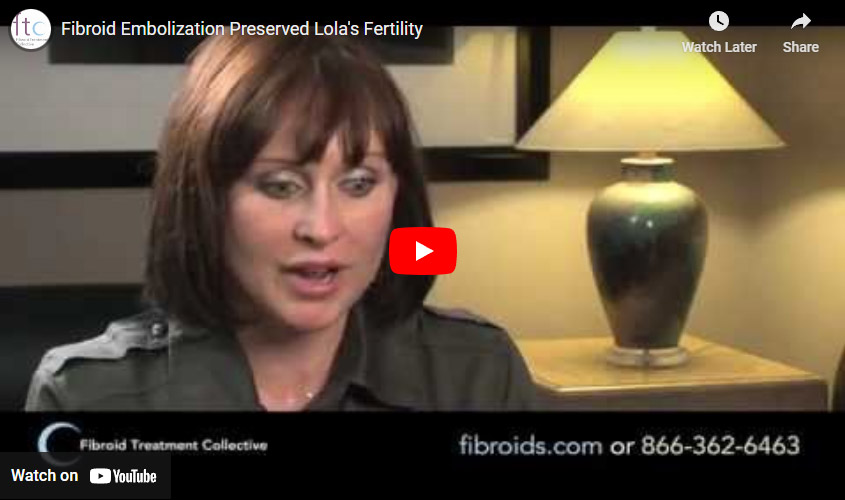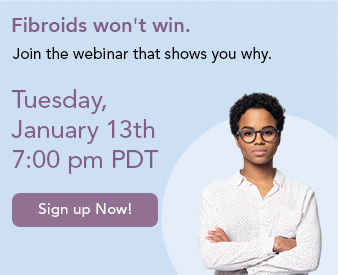Years ago, only drastic surgical methods could provide relief for women suffering from uterine fibroids. Now, a revolutionary approach exists to treat fibroids without surgery or lengthy recovery periods. With non-surgical Uterine Fibroid Embolization, you can have safe, effective relief from fibroid symptoms and get back to daily life quickly.
What Is Uterine Fibroid Embolization (UFE)?
Uterine Fibroid Embolization is a non-surgical treatment for fibroids. Instead of removing the uterus or cutting any uterine tissue, it takes a less invasive approach. UFE shrinks fibroids instead of surgically removing them. It does this by cutting off the blood supply fibroids need to grow and thrive. Once fibroids no longer have a blood supply, they starve. Then they shrink.
Embolization effectively treats fibroids of all sizes and multiple fibroids. The procedure is quick and convenient. Instead of abdominal incisions, patients have a single, small cut in the upper groin. The incision is so tiny it won’t require stitches. The wound is later closed with a band-aid.
The incision allows us to access the femoral artery, a large blood vessel that runs up the leg and into the trunk of the body. Following the femoral artery, we access the uterine artery, inject embolic material, and selectively block blood vessels feeding the fibroids. The embolic material is designed to safely block the fibroid’s source of blood and oxygen, while leaving the rest of the uterus whole and healthy. Most patients go home that same day.
Benefits of a Non-Surgical UFE
- Shorter recovery period
- Half of patients under 40 could still conceive after treatment
- Minimal strain on the body
- No scarring
- 94% success rate
- No recurrence of fibroids
- No loss of blood
- Your uterus is preserved
- Improved urinary function
- Lower risk for complications
- Reduction in heavy menstrual bleeding
- Covered by most insurances
Is This Treatment Right for Me?
If you are suffering from uterine fibroids, at least explore this alternative to surgery. It treats fibroids of nearly every size, including those that have grown large enough to resemble a pregnancy. The success rate for our patients is consistently about 94%.
The first step? An evaluation of your current health along with the size and placement of the fibroids. The doctor will then discuss your treatment goals to determine how well UFE aligns with your expectations.
With a high success rate, UFE has helped give hundreds of thousands of women relief from fibroid symptoms. The treatment avoids the stress and the risks of major surgery. It’s quick, safe, and very effective. You can get back to your life and reclaim your body in a matter of days.
- No age restrictions
- Zero incidences of allergic reactions
Uterine Fibroid Embolization Recovery
As a non-surgical procedure, the recovery period is significantly shorter than other treatments. Most patients can return to daily life and work within a week of receiving treatment.
Immediately following UFE, you may have cramps and discomfort for a day or two. This should resolve quickly. Meanwhile, any pain is managed with oral pain medication. You’ll see an immediate improvement in symptoms like excessive or prolonged bleeding. Pelvic pain and pressure end. Over time, as the fibroids begin to shrink naturally, you’ll notice diminishing abdominal distension, bloating, urinary issues, and back pain.
What Will My Results Be Like?
As embolization takes effect, expect symptom relief to be both immediate and long-lasting.
Patients experience:
- Relief from heavy menstrual bleeding
- Alleviation of chronic pain from fibroids
- Reduction in anemia
- Elimination of discomfort from sex
- Positive boost in body image
- No fibroid regrowth or reoccurrence after embolization
- The chance for a successful pregnancy
We do advise patients to wait at least 6 months after treatment before trying to become pregnant. This will give the fibroids time to shrink to a level that shouldn’t interfere with a pregnancy.
How Long Does It Take for Fibroids to Shrink After Embolization?
The moment fibroids lose their blood supply, they begin to shrink. But it may take time to notice the results.
Anywhere from a few weeks to several months, fibroids will begin to reduce in size and may eventually resorb. The rate of reduction depends on their initial size and your body’s unique reaction to the procedure. As fibroids continue to shrink, you will feel better with every passing day. The maximum amount fibroids are expected to shrink is reached at about 6 months post-procedure.
 Live Uterine Artery Embolization
Live Uterine Artery Embolization
A very informative look at a real patient’s embolization from start to finish. » Watch Video
An incision the size of a freckle is made in the upper thigh. A tiny catheter is inserted through this incision and into the femoral artery. Using x-ray guidance, a trained physician locates the arteries which supply blood to each fibroid. Microscopic inert particles are injected into the vessels, blocking blood supply that nourishes the fibroid. Without a blood supply, the fibroids begin to dwindle and shrink.
Embolization basically cures fibroids without surgery by starving them.
Why should you undergo a UFE procedure?
Most women choose to undergo a UFE procedure in order to reduce the side effects associated with uterine fibroids. Besides pain, some of the common side effects of uterine fibroids include spotting, irregular menstruation, heavy menstruation, irregular uterine bleeding, cramping, and a distended abdomen. Less common side effects of uterine fibroids include pressure in the pelvis, constipation, frequent urination, and leg pains. Pains from uterine fibroids tend to afflict the abdomen, the pelvis, and the lower back. In some cases, uterine fibroids also result in painful menstruation.
Sometimes, depending on their size and location, uterine fibroids can lead to infertility or pregnancy complications. While these negative effects are fairly rare, many women prefer to be safe than sorry when it comes to their well-being and the health of their unborn child. Women with uterine fibroids who hope to conceive are advised to either treat the fibroids or have children early. This is because uterine fibroids can grow in size throughout a woman’s life. At a later age, the uterine fibroids may be large enough to impact fertility. However, uterine fibroids tend to decrease in size once a women enters menopause.
Benefits of UFE Procedures
The benefits of UFE procedures convince many women to undergo this procedure rather than others that are also designed to serve as treatment for uterine fibroids. Some of the many advantages of UFE procedures are as follows:
Uterine Fibroid Embolization vs Hysterectomy
A hysterectomy involves the complete removal of the uterus. Which definitely ends a uterine fibroid problem. But hysterectomy is painful. And irreversible. Full recovery can take months. Current thinking is that a major surgery to remove the uterus should be the last resort, not the first recommendation.
While hysterectomy may be appropriate for certain patients, any woman exploring fibroid treatment should ask herself: Does it makes sense to remove an important female organ if I really don’t have to? How will I feel when this part of my body and my life is gone?
Hysterectomy can also have negative psychological and physical effects. In addition to accepting a total end to fertility, there are other factors to consider. The physical risks include:
- Blood clots
- Infections
- Permanent damage to the body
Fibroid surgery (myomectomy) comes with all the risks generally associated with surgery.
You can also expect significant downtime in recovery and a 50% possibility your fibroids will grow back. Roughly half of all fibroid myomectomies wind up as needing repeat surgeries. Surgically removed fibroids tend to regenerate.
The above considerations all represent significant interruptions to work, home, and personal life. Weigh the treatment. Does it answer your goals in the short term, but also for the rest of your life?
Non-surgical UFE allows you to treat fibroids in a safe yet effective manner. The 94% success rate underscores a real and non-surgical approach to fibroid relief.
Uterine Fibroid Embolization Cost
One of the benefits of our non-surgical embolization is its cost. Surgical methods come with a higher price tag. Surgery takes more time and resources, which are reflected in surgery prices. UFE doesn’t require a hospital stay or the additional charges that make hospitalization so expensive. There are other ways that a UFE saves you money. Surgeries tend to have longer recovery periods, which means more time needed to heal. More time to return to full capacity. More time to just be normal again.
The cost of UFE can vary, but it is generally covered by most major insurance. We recommend you allow us to do a quick insurance check ahead of time to give you complete information.
Schedule Your Appointment Today
Living with uterine fibroids can put enormous strain on your body and mind. Take the first step to a healthier state of everything by scheduling an appointment with us. With a non-surgical uterine fibroid embolization, you can reclaim your body quickly, safely, and effectively. Call us today to learn more about how our treatment works and all its benefits.
Lola couldn’t believe how easy treatment was. Or how happy it made her.
Honestly I would say if you have fibroids, please take control of your body, of your life, do the research, because there are options.


 Live Uterine Artery Embolization
Live Uterine Artery Embolization
